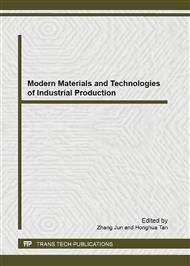p.280
p.287
p.293
p.297
p.304
p.308
p.314
p.319
p.325
A Fast Digital Printing Method for Silk Book
Abstract:
Silk fabric was first developed in ancient China, and Chinese silk also promoted the first world large-scale commercial exchanges between the East and the West. Digital printing is a technical breakthrough in the field of traditional printing and dyeing industry, which can also improve the value of the silk. There is a long history of making books by silk, and the recent revival of silk books also put forward new demands to digital printing. There exist two methods for printing book, both of which have their disadvantages. We propose a fast digital printing method for silk book which combines the advantages of the previous two methods. As the silk book has become a new choice for book collection, we believe that the proposed method will largely accelerate the popularity of silk book.
Info:
Periodical:
Pages:
304-307
Citation:
Online since:
September 2013
Authors:
Keywords:
Price:
Сopyright:
© 2013 Trans Tech Publications Ltd. All Rights Reserved
Share:
Citation:


